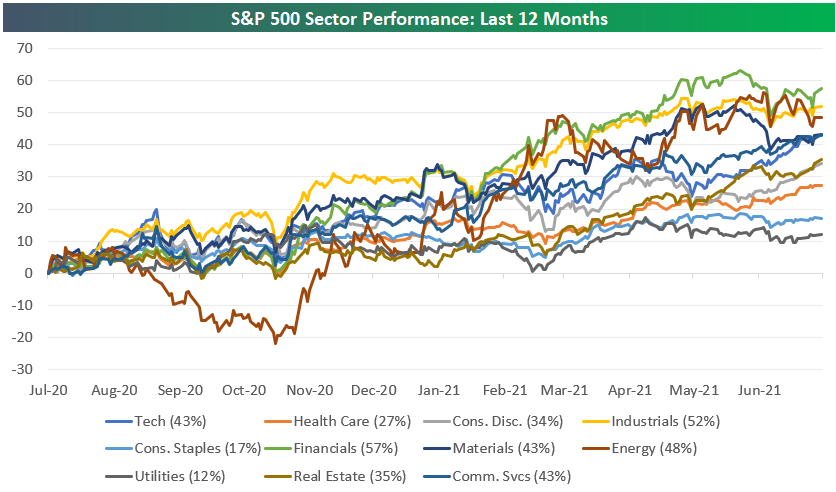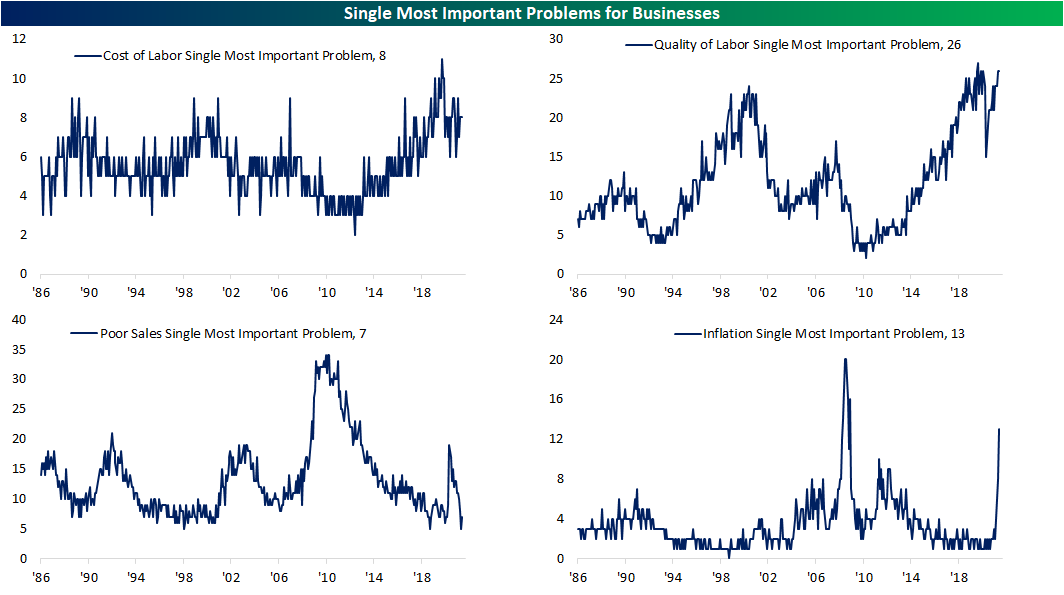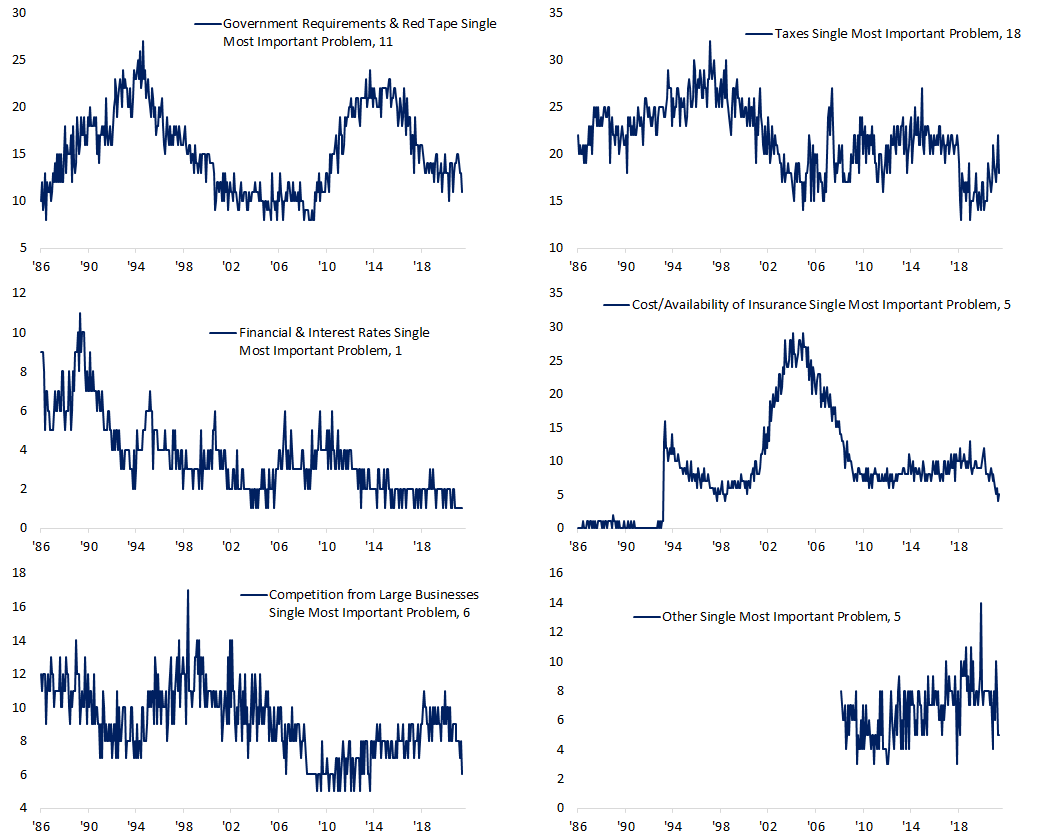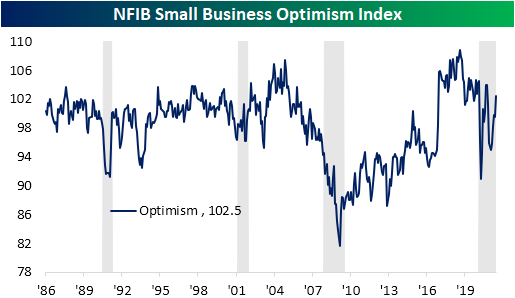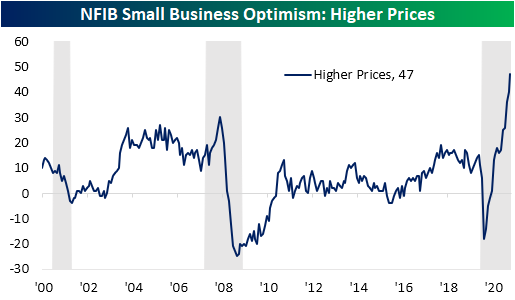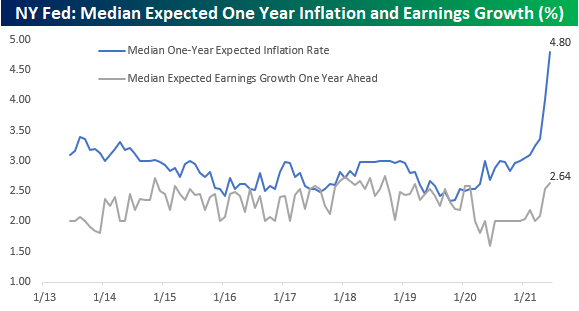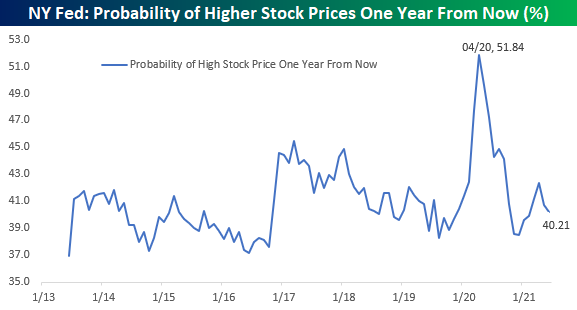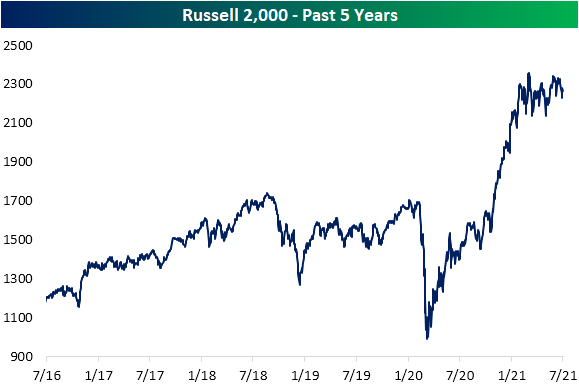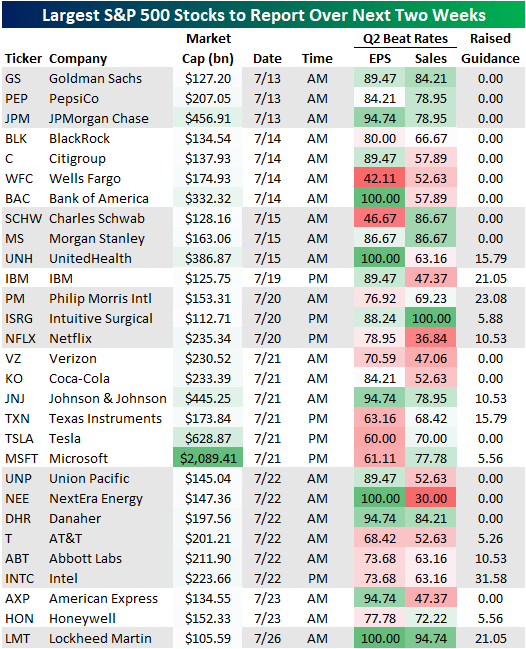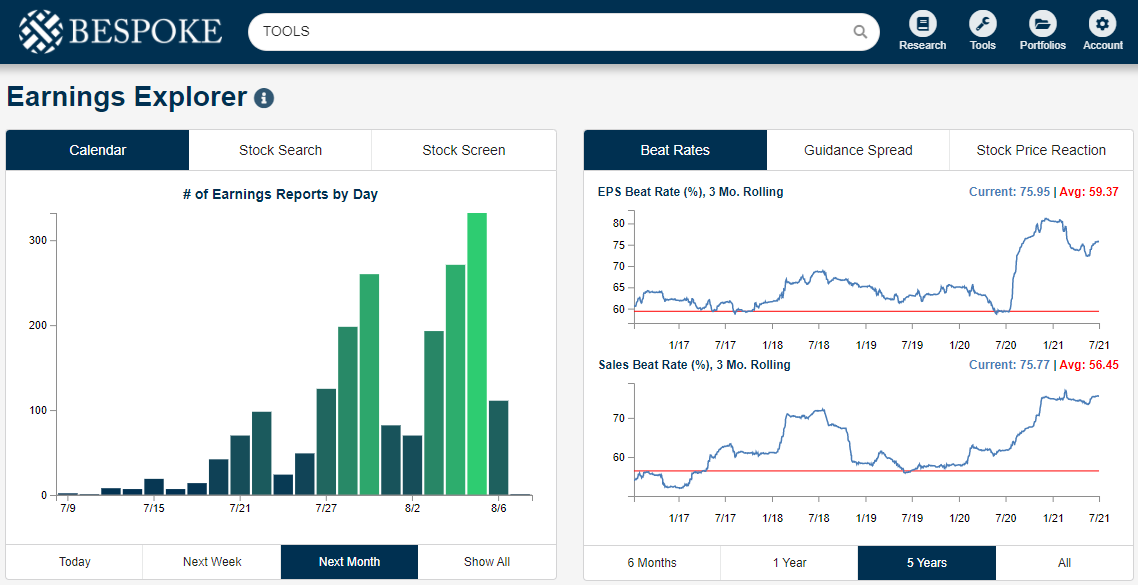2021 Gains Not Enough to Turn Energy Green
Below is a look at the path that S&P 500 sectors have taken in 2021. The Energy sector has been the clear standout from the start, taking a commanding lead early on and outperforming every other sector by more than 20 percentage points by the end of the first quarter. Since Q1, Energy has traded flat, however, which has allowed other sectors to play catch up. Even still, Energy is up 39% on the year, which is 12 percentage points better than the next best sector — Real Estate. The Financials sector ranks third best with a YTD gain of 26%. Utilities and Consumer Staples — both defensives — rank at the bottom of the pack with YTD gains of just 3-4%.
Looking back 12 months instead of on a year-to-date basis, Consumer Staples and Utilities remain the weakest, while it’s Financials that ranks first with a gain of 57%. Industrials ranks second at +52%, while Energy ranks third at +48%. Tech, Materials, and Communication Services have been the next best with gains of 43%.
Looking even further back to the start of 2020 just before COVID hit, we see that Technology moves to the top of the list with a gain of 65%. Consumer Discretionary ranks second at +50%, followed by Communication Services at +49%.
While they’ve been some of the best sectors in 2021, Financials and Industrials are in the middle of the pack with gains of 20% and 27%, respectively, since the start of 2020.
Finally, the Energy sector — up 39% YTD and by far the best sector so far in 2021 — is actually still in the red with a decline of 13% since the start of 2020. So even after a massive move higher off of the COVID-Crash lows in March 2020, those who owned the Energy sector prior to COVID aren’t even back to even yet. Click here to view Bespoke’s premium membership options and sign up for a trial to any one of them.
Inflation Concerns Surge
The NFIB surveys small businesses each month asking respondents what the most pressing problem is for their business. In the May report, the most prominent problems were government regulations and taxes with 35% of businesses reporting as such. The next biggest problems were the cost and quality of labor. While labor-related issues remain a pressing concern for the bulk of businesses going unchanged at 34% in June, government-related problems fell off a cliff. The combined reading fell from 35% down to 29%. The combined six-point drop was the largest since an identical-sized month-over-month decline from December 2014 to January 2015. Another area to see a significant decline was Competition from Big Business which fell 2 percentage points to 6%; the biggest one month decline in a year. That was matched by an increase in the number of firms reporting poor sales as their biggest issue.
In an earlier post, we noted how the June NFIB survey of small businesses showed a surge in prices and wages. As such, the percentage of businesses reporting inflation as the biggest problem surged to the highest level in over a decade. That index alone rose 5 percentage points to 13%. November 2008 was the only other month on record in which this reading rose by as much as it did in June. While it was a far less alarming increase, there was also an uptick in the percentage of businesses stating the cost/availability of insurance is an issue, although, the current reading is still below that of just a couple of months ago.
As previously mentioned, while businesses are less concerned with government-related problems, substituting for inflation concerns, the NFIB’s index of Economic Policy Uncertainty has been ticking higher over the past few months and is now at the highest level since around the time of the election although the current reading is still much more modest than back in the fall. Click here to view Bespoke’s premium membership options.
Small Businesses Want More Employees and Inventories
Early this morning, the NFIB released their June reading on small business sentiment. The headline reading has historically been correlated with changes in the political landscape and exactly that happened following last year’s Presidential election. However, the 2.9 point rise in June leaves the index fully recovered from its post-election losses as it came in at the highest level since September and October’s joint high of 104.
Breadth was generally strong across the categories of the report with seven of the ten inputs to the headline index rising month over month. As we noted earlier in the Morning Lineup, the indicators regarding employment are some of the most impressive. While actual employment changes remain negative, meaning more firms reported decreases than increases in hiring, hiring plans came in at a record high. In other words, businesses would like to be hiring more workers than they can. To make up for that, they are raising wages with both the indices for Compensation and Compensation Plans coming in at or near records. That appears to be enticing workers as there was a slight downtick in the number of firms reporting that openings are hard to fill in addition to the month-over-month uptick in the index for Actual Employment Changes.
Wages are not the only area of inflationary pressure though. More broadly, a net 47% of businesses reported higher prices. That is far and away above the normal historical range and marked the third month in a row with a record high.
Wages and prices were not the only areas to see a record. The index of Inventory Satisfaction, which measures the net percentage of respondents saying current inventory levels are “too low” versus “too high,” is also at the highest level to date. While not at a record high, that sentiment has brought Inventory Accumulation (the net percentage of companies reporting actual increases versus decreases in inventory levels) to the highest level since October which is in the top 1% of all months in the history of the survey. While companies are investing in wages and inventories, capital expenditure readings are more muted. The indices for Capital Expenditure Plans and Actual Changes in Capital Expenditures came in the 19th and 15th percentiles. Click here to view Bespoke’s premium membership options.
Inflation Expectations Surge
The New York Fed released its monthly Survey of Consumer Expectations (SCE) earlier today, and expectations for inflation over the next year surged to the highest level (4.8%) in the history of the survey (since June 2013). As shown in the chart below, inflation expectations have roughly followed actual levels of y/y CPI over the years, so with CPI surging to 5.0% in May, the spike higher in expectations shouldn’t come as too much of a surprise.
While the one year ahead forecast on the part of US consumers surged, expectations for the next three years have been more restrained, suggesting that consumers, like the Fed, expect these inflation pressures to be temporary.
In each month’s survey, respondents are also asked for their expected rate of earnings growth over the next twelve months. In this case, there’s a pretty big divergence between expected inflation (4.8%) and expected earnings growth (2.64%). In fact, the spread between the two has now widened out to a record 2.16 percentage points (second chart). There’s only so long that inflation can grow at nearly twice the rate of earnings growth.
Among other questions, the SCE also asks consumers about their views towards the stock market. In this month’s survey, only 40.2% of consumers expect stock prices to be higher one year from now. In an environment where most sentiment surveys are overwhelmingly bullish, this survey of stock prices seems somewhat restrained. One interesting aspect of this part of the survey, though, is that in early 2020, when most sentiment surveys saw a spike higher in bearish sentiment, this one saw bullish sentiment surge to the highest level in the history of the survey. Click here to view Bespoke’s premium membership options and to sign up for a trial to any one of them.
Sleepy Small Caps
In the couple of years headed into the pandemic, the Russell 2,000 traded in a range having failed to take out its August 2018 high. After falling harder than large caps during the COVID crash, the Russell 2000 surged off of those lows and rallied 128.5%. Over the last six months, though, small caps have been stuck in another sideways range. As shown below, while the index had been on a strong run at the end of 2020 and into January of this year, the push higher has stalled out over the past several months.
While positive over the last six months (top left chart below), the Russell’s 8.29% gain has been middling relative to history ranking in just the 58th percentile. Further, with the index having trended sideways over the past few months, there has only been a 13.82% range between its 6-month closing high and low. That is actually at the low end (20th percentile) of the index’s historical six-month ranges. That lack of volatility comes after a historic move to the upside though.
As shown in the right-hand charts below, while current performance readings are coming back down to Earth given the past few months narrower range, the past year has seen record year-over-year changes. In fact, even after falling dramatically, the current reading is still in the top 3% of all year-over-year changes. The 52-week high/low range similarly hit record levels in the past year which have since cooled off but they too remain in the top decile of the index’s readings. In other words, the Russell 2,000 has been somewhat flat over the past several months, but it should make sense following the past year’s historic move higher. Click here to view Bespoke’s premium membership options.
Bespoke’s Morning Lineup – 7/12/21 – Grounded
See what’s driving market performance around the world in today’s Morning Lineup. Bespoke’s Morning Lineup is the best way to start your trading day. Read it now by starting a two-week free trial to Bespoke Premium. CLICK HERE to learn more and start your free trial.
“I believe that space travel will one day become as common as airline travel is today.” – Buzz Aldrin
While Richard Branson blasted himself into space over the weekend, futures are a lot more muted this morning as large-cap US equities are indicated modestly lower to start the week. One pocket of strength has been technology as the Nasdaq is trading moderately higher as a just-announced EU delay of implementing a digital tax has provided a boost.
Read today’s Morning Lineup for a recap of all the major market news and events from around the world, a discussion of economic data out of Japan, the latest US and international COVID trends including our vaccination trackers, and much more.
Friday was a good close to the week for small-cap stocks, but it wasn’t enough to erase the damage of the prior days as they were still the worst-performing market cap sector for the week. In the five days ending Friday, mega-cap dominated indices like the Nasdaq 100 and S&P 100 both rallied more than 1.5% and finished the week at either overbought or ‘extreme’ overbought levels. Other large-cap-oriented indices also rallied around 1% last week and also headed into the weekend at overbought levels. At the bottom of the list, all the small-cap focused index ETFs actually fell around 2% while the Micro-Cap ETF (IWC) dropped over 3%. So, while large caps are all overbought heading into the week, mid and small-cap index ETFs are either trading below or barely hanging on to their 50-DMAs.

Bespoke Brunch Reads: 7/11/21
Welcome to Bespoke Brunch Reads — a linkfest of the favorite things we read over the past week. The links are mostly market related, but there are some other interesting subjects covered as well. We hope you enjoy the food for thought as a supplement to the research we provide you during the week.
While you’re here, join Bespoke Premium with a 30-day free trial!
Collapse
Liquidity Risk in $1.2 Trillion of Bond Funds Exposed by Covid by Sam Potter (Bloomberg)
An argument that bond ETFs are a source of systemic risk because authorized participants who facilitate ETF creation and redemption have funding constraints. [Link; soft paywall]
Credit Suisse’s #Zoltan Warns of Trouble Ahead in Money Markets by Julia-Ambra Verlaine (WSJ)
An alarmist interpretation of the insights offered by Credit Suisse money market maven Zoltan Pozsar, the dean of analysts who follow the complex flow of funds through short-term funding markets and between various financial institutions. [Link; paywall]
The Collapse of Overend, Gurney, and Co. by Global Financial Data (Threadreader App)
How a bank with a simple, predictable, and reliable business model turned into a massive failure on the back of rampant railroad speculation during the middle of the industrial revolution. [Link]
GOATs
Spelling bee champ Zaila Avant-garde is basketball whiz — and Guinness World Record holder by Scott Gleeson (USA Today)
The most impressive 8th-grader we’ve ever come across is Zaila Avant-garde, a teenage phenom who not only won the national spelling bee this week but is also an impressive athlete who can shoot a basketball better than most adults. [Link]
Column: Don’t miss it. Shohei Ohhhhh-tani is delivering the best season in baseball history by Bill Plaschke (LAT)
Los Angeles Angels pitcher Shohei Ohtani is not only leading the majors in dingers and nears the top in runs, RBIs, and slugging, but is also 4-1 on the mound with an impressive 3.49 ERA and 87 Ks. [Link]
Regulation
FACT SHEET: Executive Order on Promoting Competition in the American Economy (White House)
This week the Biden Administration announced a new initiative focused on raising competition, especially in the labor market. The list is exhaustive and includes some areas that more conservative voices have focused on for years. Regardless of the political content, this is an interesting new approach to regulatory policy. [Link]
SEC Charges Three Individuals with Insider Trading (SEC)
Insider trading charges have been leveled against individuals connected to Long Blockchain Company, a penny stock that pivoted from iced tea to blockchain, driving a massive spike in shares. Two are already in litigation related to a prior stock manipulation scheme. [Link]
A third of Wisconsin’s wolves killed after losing protections this year, study says by Douglas Main (National Geographic)
After wolves had their protected species status revoked, Wisconsin allowed hunting of the animals and the end result was roughly one-third of the species was killed in the state in just one year. [Link; soft paywall]
Q2 Reports
Startups have never had it so good by Alex Wilhelm and Anna Heim (TechCrunch)
Second quarter data shows that strong venture dealmaking activity has continued with record dollar value for invested funds. As a result, deal multiples and overall sizes are surging. [Link]
Mall Index – Q2 2021 by Ethan Chernofsky (Placer.ai)
Compared to 2019, indoor mall visits were down 8.1% in June, versus a decline of as much as 29% in February 2021. Outdoor mall traffic has held up better but is still down versus 2019. [Link]
Research
Observing Many Researchers Using the Same Data and Hypothesis Reveals a Hidden Universe of Uncertainty by Breznau et al (MetaArXiv Preprints)
A hilarious paper that shows wildly different scientific results from the same initial data that cannot be explained by observable characteristics of models specified. The results suggest caution is warranted whenever interpreting scientific findings. [Link]
Stabbing
The Game That Ruins Friendships and Shapes Careers by David Klion (Foreign Policy)
A dive into the rough-and-tumble world of Diplomacy, a superficially simple board game that serves as a perfect training ground for the sort of realpolitik that dominates modern Washington. [Link]
Read Bespoke’s most actionable market research by joining Bespoke Premium today! Get started here.
Have a great weekend!
Largest S&P 500 Stocks Reporting Over Next Two Weeks
Earnings season begins in earnest next week with the first of the big banks out with Q2 results. In the table below, we show the 29 stocks set to report over the next two weeks with market caps above $100 billion. Using our Earnings Explorer, we show historical Q2 earnings and sales beat rates versus analyst expectations.
As shown, Goldman Sachs (GS), Pepsi (PEP), and JP Morgan (JPM) kick things off on Tuesday before the open. BlackRock (BLK), Citigroup (C), Wells Fargo (WFC), and Bank of America (BAC) all report on Wednesday before the open, and then Schwab (SCHW), Morgan Stanley (MS), and UnitedHealth (UNH) report on Thursday morning. The following week we’ll hear from a number of big blue-chips like IBM, Netflix (NFLX), Verizon (VZ), Coca-Cola (KO), Johnson & Johnson (JNJ), Tesla (TSLA), Microsoft (MSFT), Intel (INTC), American Express (AXP), and Lockheed Martin (LMT).
Of all the stocks set to report over the next couple of weeks, there are a handful that have never missed EPS estimates on Q2 earnings. Those names include Bank of America (BAC), UnitedHealth (UNH), NextEra Energy (NEE), and Lockheed Martin (LMT). Intuitive Surgical (ISRG) is the only one to have never missed Q2 sales estimates. Turning to a look at guidance, Intel (INTC) is the company on this list to most often raise guidance although its sales and EPS beat rates are more middling. LMT and Philip Morris (PM) also have raised guidance more often than other stocks on the list. For more in-depth analysis of earnings and how the stocks below have historically traded in reaction to their Q2 reports, join Bespoke Premium today!
The Most Volatile Stocks on Earnings — July 2021
The Q2 2021 earnings reporting period starts up next week with five of the six major banks reporting their quarterly numbers. As we do ahead of each earnings season, below is a look at the most volatile stocks on earnings. These are the stocks that have historically experienced the biggest one-day moves in reaction to their earnings reports.
While earnings season starts up next week, we really don’t start seeing a large number of daily reports until the end of July and the first week of August. (Track upcoming earnings reports and monitor earnings-related trends using our Earnings Explorer tool.)
Below is a list of the most volatile stocks on earnings that have at least 8 quarters (2 years) of historical earnings reports. These stocks have historically seen the biggest share-price reactions to their earnings reports on the first trading day following the report. (For stocks that report before the open, we are looking at its one-day change on that trading day. For stocks that report after the close, we are looking at its one-day change on the next trading day.)
As shown, Stitch Fix (SFIX) ranks first with an average absolute one-day change of +/-18.62% in reaction to earnings. Cardlytics (CDLX), Pinterest (PINS), Snap (SNAP), and Roku (ROKU) rank two through five on this list, all with average one-day moves of +/-17%. Other notable stocks on the list include Lovesac (LOVE), Groupon (GRPN), The Trade Desk (TTD), Nio (NIO), Cloudera (CLDR), and ZScaler (ZS).
The list above included any stock that has at least 2 years of quarterly reports. Below we show a list of the most volatile stocks on earnings that have at least 5 years (20 reports) of quarterly reports. (Stocks typically see decreasing earnings volatility over time simply because of more data points.)
Of the stocks with at least 5 years of quarterly earnings data, The Container Store (TCS) ranks as the most volatile on earnings with an average absolute one-day move of 16.80%. Impinj (PI) ranks 2nd followed by Groupon (GRPN), At Home Group (HOME), Infinera (INFN), and Fluidigm (FLDM). Other notable stocks on this list include Enphase Energy (ENPH), Yelp (YELP), Stamps.com (STMP), LendingTree (TREE), Twitter (TWTR), RH (RH), Wayfair (W), Netflix (NFLX), iRobot (IRBT), Chegg (CHGG), 3D Systems (DDD), and Etsy (ETSY).
Our final list of volatile stocks on earnings only includes names that have at least 10 years (40 quarterly reports) of earnings history. Amazingly, despite being well-established companies, they still experience an average one-day move of at least +/-10% on their earnings reaction days. In other words, they normally see their market value rise or fall by at least 10% at least once per quarter when they report earnings.
At the top of this list are Infinera (INFN), Stamps.com (STMP), Conn’s (CONN), Netflix (NFLX), and Fossil (FOSL). Other notables include iRobot (IRBT), 3D Systems (DDD), Overstock.com (OSTK), Align Tech (ALGN), Guess? (GES), Crocs (CROX), and TravelCenters of America (TA).
If you’re looking for action this earnings season, you’ll likely find it in the names listed in these tables. Unfortunately, without a crystal ball, there’s no way to know whether the big moves will be to the upside or the downside! Click here to start a trial to Bespoke Institutional and gain access to our Earnings Explorer tool.
Value Has Given Up The Ghost
In the last few months of 2020 and throughout 2021, the S&P 500 Value ETF (IVE) was consistently outperforming its growth counterpart (IVW). Since its most recent high in early June, though, IVE has given up the ghost falling 2.5%. Although not a dramatic decline, IVE’s drop has coincided with a rally of 7.3% in IVW and an even larger 12.5% rally off the May 12th lows.
With growth having gained so much ground on value, on Tuesday, IVW’s year-to-date performance actually moved above that of IVE. That has continued to be the case through the rest of the week as IVW is currently outperforming IVE on a year-to-date basis by almost a full percentage point. Additionally, looking at the past year’s relative strength between the two ETFs, the recent divergence in performance has resulted in relative strength reverting back to zero meaning growth and value have roughly performed in line with one another over the one year span. Click here to view all of Bespoke’s premium membership options and sign up for a trial to any one of them.

